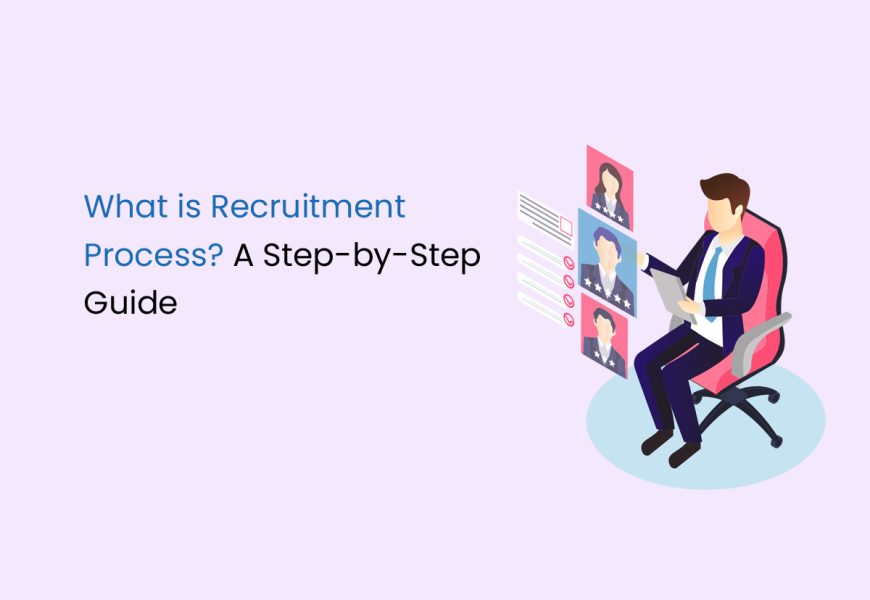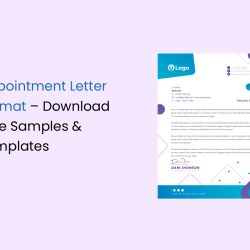An effective recruitment process is crucial for organisations as it enables them to attract diverse applicants and carefully screen and select the ideal candidates for each position. By implementing a well-designed recruitment process, organisations can also build a high-performing team of employees who are capable of driving the organisation towards greater success.
What is a Recruitment Process?
The recruitment process refers to a specific strategy developed by an organisation to identify and hire new employees. Typically, the HR department takes the lead in carrying out the recruitment process, often in collaboration with hiring managers. This strategic process consists of various stages the organisation follows to locate, attract, and onboard new talent. These stages typically involve identifying open positions, evaluating job requirements, drafting job descriptions, receiving and assessing applications, shortlisting candidates, conducting interviews, and selecting and hiring the best-suited candidates. By implementing an effective recruitment process, an organisation can potentially reduce employee turnover and ensure that only competent individuals are brought on board.
Importance of a Strong Recruitment Process
A strong recruitment process is important for the following reasons:
- Attracting Qualified Candidates: An effective recruitment process is designed to attract suitable candidates specifically. By tapping into relevant talent pools and enticingly showcasing the company’s opportunities, organisations can successfully bring in well-qualified applicants who are better suited for the available positions.
- Building a Talent Pool: A large and diverse pool of candidates is crucial in a competitive job market. A robust recruitment process guarantees access to a wide range of talented individuals. This enables the company to fill current positions swiftly and creates a talent pipeline for future needs.
- Efficiency and Speed: An effective recruitment process reduces the time needed to locate and onboard suitable candidates. This results in quicker role placements, lessening the impact of vacancies and enabling the company to sustain productivity.
- Improving Candidate Experience: A streamlined and professional recruitment process is essential for providing candidates with a positive experience. This reflects positively on the company’s reputation and improves the likelihood of attracting high-quality talent. Positive experiences can also result in higher acceptance rates and increased candidate engagement during the hiring process.
- Cost Savings: Companies can cut costs by simplifying their recruitment processes. This includes saving money on advertising, reducing the time it takes to hire new talent, and minimising the expenses associated with unfilled positions.
- Enhancing Employer Brand: The recruitment process frequently involves potential employees’ initial interaction with a company. A favourable and professional recruitment experience can bolster the company’s image as a highly regarded employer, ultimately simplifying the process of attracting top-tier candidates in the future.
- Quality of Hire: An effective recruitment process involves thorough screening and selection methods to guarantee that the selected candidates are well-suited for the job and the company culture. This contributes to improved performance, increased employee satisfaction, and reduced turnover rates.
- Strategic Alignment: Ensuring that recruitment aligns with a company’s strategic goals is crucial for attracting talent that supports long-term objectives. This strategic approach plays a key role in developing a workforce that contributes to the company’s growth and success.
Factors Influencing the Recruitment Process
Here are the factors influencing the recruitment process:
- Size of the Organisation: When it comes to the recruitment process, the size of an organisation plays a significant role. Larger organisations tend to have more resources dedicated to recruitment, including specialised HR teams, advanced recruitment technologies, and extensive networks. Big companies often benefit from well-established brands, making it easier to attract candidates. On the other hand, smaller companies may need to exert more effort to capture the attention of top talent, and larger organisations may need to fill multiple positions simultaneously. They can often benefit from bulk recruitment strategies, while smaller firms typically focus on filling one role at a time with particular needs. Larger firms may offer more internal transfers and promotions opportunities, which can appeal to candidates seeking long-term career growth.
- Salary Structure: The salary structure is a crucial component of any organisation as it dramatically impacts the attraction and retention of top talent. Key considerations for a strong salary structure include offering competitive salaries, providing transparent information about the structure, offering incentives and bonuses, and ensuring equity and fairness in pay across similar roles. These factors can help build trust, motivate candidates to apply, and enhance the organisation’s reputation.
- Work Culture and Working Conditions: An organisation’s work culture and working conditions are crucial for recruitment. Companies prioritising a healthy work-life balance, offering flexible working arrangements, and focusing on employee well-being are more likely to attract candidates who value these factors. Additionally, a positive, inclusive work culture aligned with company values can appeal to job seekers with similar ethics. Initiatives such as wellness programs and mental health support can further enhance an organisation’s attractiveness to potential candidates.
- Growth Rate of an Organisation: An organisation’s growth rate can significantly impact its appeal to potential employees. Quickly expanding companies offer more avenues for career growth, making them appealing to ambitious candidates seeking advancement opportunities. However, rapid growth can raise concerns about job security, as it may signal potential instability within startups and other high-growth firms. On the upside, organisations experiencing robust growth are usually more inclined to invest in their employees by offering training, development programs, and career advancement opportunities.
- Current State of Employment in the Economy: The current state of employment in the economy is significantly impacted by various factors. One of the key influences is the labour market conditions—low unemployment rates in a tight labour market provide candidates with more options, compelling companies to offer attractive packages to secure top talent. However, companies may have a larger pool of candidates in a high unemployment market. Economic stability also plays a crucial role, as economic downturns can lead to hiring freezes or reductions in the workforce. At the same time, a booming economy typically results in increased hiring and expansion. Moreover, industry trends, such as technological advancements or regulatory changes, can also impact recruitment needs and strategies, with industries experiencing rapid technological change usually having a higher demand for tech-savvy candidates.
Benefits of a Good Recruitment Process
Here are the benefits of a good recruitment process:
- Time-Saving: Organisations are now streamlining the application process by customising it for a more positive candidate experience, using an Applicant Tracking System (ATS). This system allows recruiters to efficiently manage their tasks and address any bottlenecks that could lead to bad hires, ultimately saving time and improving the hiring process.
- Engaged Employees: Engaged employees are motivated, enthusiastic, and committed. A recruitment process focused on hiring candidates with a work history demonstrating commitment, consistency, and career growth helps predict their future dedication within the organisation. Conducting in-depth interviews is the most effective way to assess the enthusiasm and efficiency levels of potential candidates.
- Proactive Recruiting: A well-designed recruitment process aims to identify gaps in advance and ensure that the talent recruitment team is aligned, enabling them to take a proactive approach. This approach allows recruiters to quickly review and refine recruitment strategies, leading to better quality hires. It is essential to evaluate the factors that interest and influence potential new hires, as this can uncover issues in the recruitment process and help identify benefits that can make the company more attractive to job seekers.
- Improved Performance: An applicant actively seeking a job change is not necessarily at risk of losing their current job due to poor performance. A thorough selection process helps assess the candidate’s abilities and skills related to job performance. Competent recruiters use interviews to uncover the applicant’s strengths, weaknesses, and areas for development. This process is crucial in predicting the future productivity of the employee.
Types of Recruitment
Here are a few recruitment methods:
- Direct Advertising: Direct advertising is a method of promoting job openings through various online platforms such as job boards, career websites, and social media. This approach allows companies to reach a wide pool of potential candidates, helping to increase the visibility of the employer brand. However, it’s important to note that this method may also attract applications from individuals who may not meet the qualifications for the position.
- Recruitment Agencies: Recruitment agencies can be a valuable resource for managing the recruitment process and selecting candidates, allowing companies to focus on more critical tasks. This can be particularly beneficial for filling challenging or specialised positions with limited internal HR resources. However, their services can come with a significant cost and may result in less control over the recruiting process.
- Internships: Internships can be viewed as a preliminary stage for potential hiring. They provide soon-to-be graduates with valuable experience while allowing employers to evaluate them as potential colleagues who could align well with the company’s culture. They also serve as an effective means of identifying talent early on and recruiting them to work for the company.
- Recruitment Events: Recruitment events, also referred to as job fairs, career expos, and career fairs, are organised by companies to evaluate multiple potential candidates efficiently. This approach to recruitment not only saves time and money but also provides applicants with an opportunity to gain insight into your organisation and determine if they are interested in joining your team.
- Employee Referral Programs: Employee referral programs offer employees the opportunity to recommend their family or friends for open positions within organisations. This is a cost-effective way to screen potential candidates and often brings in individuals already familiar with the company’s operations.
- Talent pool Databases: Talent Pool Databases refer to the pool of candidates who were not hired for an open position but had impressive CVs. Looking through retained candidates can save time in your future recruitment process.
Recruitment Process
The recruitment process is as follows:
Identifying Vacancies and Hiring Needs
Understanding the hiring needs and identifying job vacancies is crucial in ensuring that open positions are filled with the most qualified talent. This process involves more than just reviewing the job description; it requires engaging with the hiring manager to gain insights into the role’s day-to-day responsibilities, tasks, and future plans.
Determining the required skills and experience for success involves considering technical and soft skills. It’s important to evaluate the team’s current strengths and identify any knowledge gaps the new hire can fill. Cultural fit is also essential, as finding someone who integrates well with the team for long-term success is crucial.
Creating a Job Description
Crafting a compelling job description is essential for attracting suitable candidates who are well-suited to both the position and the company’s values. By having a clear understanding of the ideal candidate, it’s possible to create a description that directly resonates with them.
Vital components of a successful job description involve clearly defining the position’s roles and responsibilities and emphasising its impact on the team and company objectives.
Using powerful action verbs and avoiding overly technical language helps ensure the description is easily understandable to a diverse pool of qualified candidates.
A well-crafted job description is a powerful tool for drawing in qualified individuals who align with the company’s culture and principles.
A job description should include:
- Company Name & Description
- Job Title
- Department
- Industry Pay
- Benefits Offered
- Description of Duties
- Demand (specific skill set, knowledge, experience or training required for the job)
- Qualities that are nice to have and would be an added advantage
- Core Values
- Location
- A conversational CTA
Talent Search
In recruitment, finding the right talent, drawing them in, and spurring them to apply are essential elements of the process. Promoting a detailed job listing within the company and to the public is necessary to ensure maximum visibility. Internal promotion can lead to employee referrals, while external promotion on social media platforms, top job boards, and industry publications can help broaden the candidate pool. Here are two primary sources of recruitment that can be utilised for a talent search:
Internal Sources
Internal recruitment is an effective strategy that aims to motivate current employees, leading to increased productivity, job satisfaction, and a greater sense of security within the organisation. Additionally, it helps lower attrition rates and reduces the costs and efforts associated with external recruitment processes.
- Internal Talent Mobility: Internal talent mobility refers to the practice of shifting employees within an organisation to different roles, teams, or locations. It includes job transfers, promotions, demotions, and other strategies to utilise the existing workforce effectively.
- Job Transfer: Organizations can fill job vacancies by relocating suitable employees to different locations without changing their roles, status, or compensation.
- Job Promotion: High-performing employees can be promoted to senior positions with increased responsibilities and higher pay. Promotions motivate employees and help reduce turnover.
- Job Demotion: Underperforming employees may be demoted to lower positions based on their performance, allowing them to fulfil roles better suited to their abilities.
- Employee Referral Program: Employees can assist in recruitment efforts by sharing job openings on their social media networks. An employee referral program with rewards for successful hires can expedite the hiring process.
- Retired Employees: In urgent situations or for critical projects, retired employees can be rehired temporarily until suitable replacements are found.
- Previous Applicants: Maintaining a database of prior applicants provides a valuable resource for reaching out to potential candidates when new positions become available.
External Sources
External recruitment allows access to a larger pool of qualified candidates, which can speed up the hiring process and minimise the potential for bias or favouritism.
- Job Advertisements: Utilizing print and digital media advertisements can play a crucial role in establishing a strong brand identity and drawing in talented individuals. Digital media, in particular, can deliver superior outcomes at a lower cost.
- Job Portals: Job portals are crucial in connecting companies with potential candidates. Job seekers who seek better career opportunities highly favour these platforms, which also serve as excellent sources for recruiters.
- Company Careers Site: Creating a careers site that is mobile-friendly, branded, and aligns with the company’s culture while also integrating with social profiles can help attract top talent. Integrating an applicant tracking system (ATS) into the site can enhance the candidate experience by providing a customisable application process.
- Social Networking Platforms: Finding highly skilled candidates is essential, and platforms such as LinkedIn, Facebook, and Twitter provide access to a massive pool of talent. With a combined user base of 535 million, these social media sites are crucial for connecting with top-tier professionals.
- Placement Agencies: Placement agencies offer an effective solution when filling challenging job positions. They utilise a range of tools and strategies to connect with high-quality candidates in a timely manner and at a lower overall expense.
- Job Fairs: Job fairs offer convenient access to potential candidates to fill multiple positions. These events also provide avenues to boost brand recognition and establish connections with other businesses.
- Campus Placements: Campus placements offer a cost-effective and efficient method for identifying and recruiting enthusiastic, highly motivated candidates eager to contribute to the company’s success.
- Professional Bodies: Professional management bodies keep current databases of skilled and certified professionals in their specific industries. These databases serve as valuable resources for identifying and recruiting top talent in the industry.
Screening and Shortlisting Candidates
When managing many job applications, employing a strategic approach to streamline the process can be helpful. Here are some steps that can help you transition from a pile of resumes to a shortlist of top candidates:
- Use the job description as a filter to prioritise candidates whose skills and experience align with the identified ‘must-haves.’ Online screening tools can automate this step, saving valuable time.
- Concentrate on conducting thorough reviews of the most promising applications. Look for strong communication skills in cover letters and resumes and specific achievements that demonstrate the candidates’ capabilities.
- Conduct phone screenings to assess candidates’ enthusiasm, communication style, and basic qualifications. This can help shortlist candidates who are a good cultural fit and genuinely interested in the opportunity.
By following these steps, the recruitment process can become more efficient and effective, ensuring that the most suitable candidates are identified and moved forward in the selection process.
Interviewing and Assessing Candidates
After the initial shortlisting, applicants progress to the interview stage, where they are considered for a job offer or informed of rejection. Multiple interviews may be arranged for each candidate depending on the organisation’s hiring team and specific recruitment criteria.
- Telephonic Screening/Video Interviewing: Telephone or video interviews offer a fast, simple, and convenient method to assess candidates and their abilities. This preliminary interview is also the first chance to create a strong impression on potential employees. Although it should be brief, evaluating candidates based on the knowledge, skills, and experience specified in the job description is crucial to weed out unsuitable profiles early in the process.
- Psychometric Testing: Psychometric testing plays a vital role in the selection process by offering valuable insights into the long-term performance and productivity potential of potential employees. This unbiased assessment efficiently identifies the most suitable candidates for the job by providing a comprehensive personality profile that includes behaviour, flexibility, aptitude, creativity, communication, and relevant problem-solving skills.
- Face-to-Face Interviewing: In-person interviews are thorough and usually occur as the last stage before a job offer is made. Senior management often conducts these interviews with a select group of exceptional candidates. Finalising the top choice and having a backup candidate in mind is important.
Tips for Interviews
- Interviews are a two-way interaction, where candidates also evaluate if your company suits them. It’s essential to be courteous and respectful, showcasing both the role and your organisation’s benefits.
- To gain valuable insights into each candidate’s professional background, prepare relevant and specific questions that directly relate to the role.
- Avoid asking abstract or irrelevant questions merely to gauge reactions. Focus instead on inquiries that help determine whether the candidate possesses the qualifications and skills necessary for success in the position.
Job Offer
After identifying a standout candidate, crafting a compelling job offer to secure their talent for the team is crucial. Top candidates often have multiple options, so responding promptly and presenting a competitive offer that includes salary, benefits, and a start date is vital.
Clearly outlining the details of the position, including responsibilities, compensation package, and career development opportunities, sets expectations and fosters a strong working relationship from the outset.
While securing the top choice is ideal, having a backup plan or silver-medalist candidate is crucial. If the first choice declines, being prepared to revisit the shortlist or efficiently resume the search efforts is essential.
Onboarding
When onboarding new employees, going the extra mile is essential to helping them feel welcome and settled. In addition to providing necessary information and supplies, consider arranging a special lunch and encouraging colleagues to engage in non-work-related conversations to make the new hire feel more at home.
Tips for Recruitment
Some tips for effective recruitment are as follows:
- It’s important to prioritise a seamless recruitment process as it can create a positive impression of the company among candidates. Even if individuals are not chosen for a position, a positive experience may encourage them to refer others to apply.
- A well-structured offboarding process ensures that departing employees leave with a positive view of the company. This positive experience can encourage them to refer others to the company or even consider returning in the future.
- Many job seekers today are attracted to companies that offer flexible working arrangements, such as the option to work from home. This flexibility can help companies appeal to a larger and more diverse pool of talented candidates.
- It is important to note that candidates increasingly value a diverse workplace. Embracing diversity enriches company culture and expands the talent pool, drawing in candidates from different backgrounds and with diverse perspectives.
Tools to Boost Your Recruitment Process
Recruitment is a mixture of multiple smaller but equally pain-staking processes that require a lot of documentation and management. We have curated a list of all the tools that help you in this process better. Check it out below:
Handle Your Data Well
- Google Drive: Offers unlimited storage, secure data sharing, and live video conferencing, making it ideal for your growing data needs.
- Evernote: A centralised platform that stores everything in one place, even allowing you to search handwritten notes quickly.
- Dropbox: Share important files without syncing, making it a simple, free tool for recruiters.
Automation for Recruiters
- IFTTT: Automates recruitment processes, syncing your apps for increased efficiency.
- Zapier: Links web apps and workflows, helping you collaborate more effectively.
- Calendly: A smart scheduling tool that is perfect for global sourcing with time zone intelligence.
Organise Your Time Better
- Trello: Stay organised with user-friendly workflows that keep you on top of tasks.
- Wunderlist: Manage tasks, automate reminders, and streamline your recruitment process with ease.
- Boomerang for Gmail: Reach candidates across time zones by scheduling emails.
Make Sourcing Easier
- Github: Ideal for sourcing technical talent with 10+ million developers and 25 million repositories.
- SourceHub: Cuts sourcing time by finding potential employees across 15 social sites.
- Tweetdeck: Get to the right candidates faster through this social media dashboard.
Interviewing Made Simple
- SurveyMonkey: Test candidates on specific skills to streamline the selection process.
- Google Hangouts: Screen multiple candidates no matter their location.
- MindTools: Assess candidates’ interests, personality, and aptitude to narrow down the talent pool.
Candidate Engagement
- Mixmax: Customise hundreds of emails to keep candidates engaged while focusing on recruiting.
- 360social: Connect with top candidates from over 140 social networks.
- Gorgias Templates: Create and share personalised email templates with ease using keyboard shortcuts.
If this all seems too much and too complex, you are right. However, you don’t have to worry about running and operating multiple apps because we have a one-stop solution for all your needs. TankhaPay is a mobile-responsive platform that automates your entire recruitment process. Request a callback today!
Frequently Asked Questions about the Recruitment Process
What is called Recruitment?
Recruitment encompasses the full range of activities involved in seeking out, evaluating, selecting, and conducting interviews with potential candidates for positions within a company, whether permanent or temporary. It also involves the process of selecting individuals for unpaid roles.
What are the Seven Steps of the Recruitment Process?
The seven steps of the recruitment process are:
- Identifying the Hiring Needs
- Preparing the Job Description
- Talent Search
- Screening and Shortlisting
- Interviewing
- Evaluation and Offer of Employment
- Introduction and Induction of the New Employee
How long does the Recruitment Process take?
The time it takes to complete the recruitment process can vary significantly due to factors like the role's complexity, the number of candidates, and internal processes. The process can take anywhere from a few weeks to several months.














